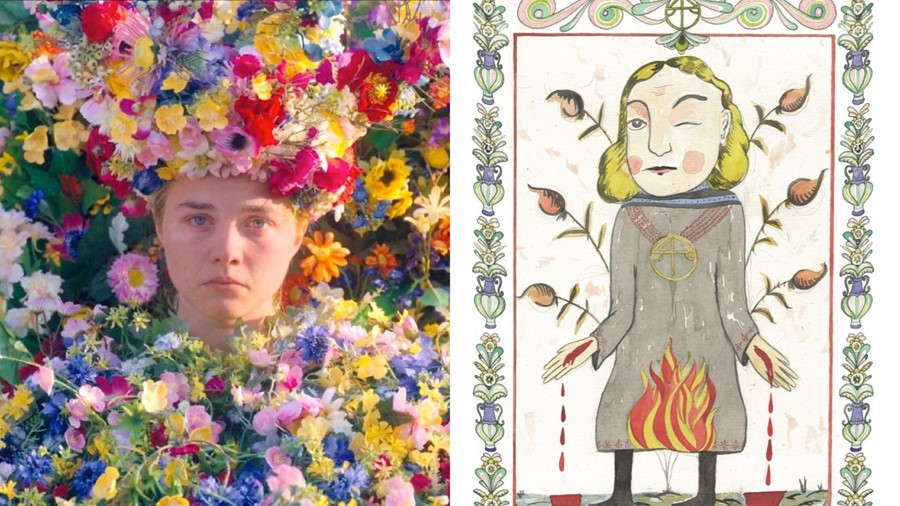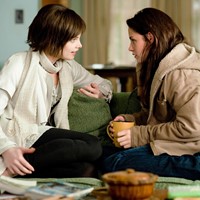Stockholm-based Ragnar Persson takes us behind the film’s eerie artwork, and their bloody, gory, ritualistic influences
It’s been one year since the release of the sun-drenched folk-horror tale, Midsommar, yet Ari Aster’s unsettling depiction of the Swedish midsummer festival, and its pagan roots, is as disturbing as ever.
As with Aster’s debut film, Hereditary, in which a doll’s house acts as a metaphor for the gradual unravelling of a family driven apart by a demonic cult, Midsommar, too, is littered with symbolism. Central to this is the elaborate murals painted, drawn, and stitched onto various objects in the actual film, which act as eerie premonitions of what’s to come. In one image, we see two people having sex surrounded by onlookers, a clear reference to the chorally-assisted sex ritual Jack Reynor’s character Christian is lured into. Later, in Siv’s house, Christian glances at an image on the wall of a bear being burnt alive, further foreshadowing of his untimely death.
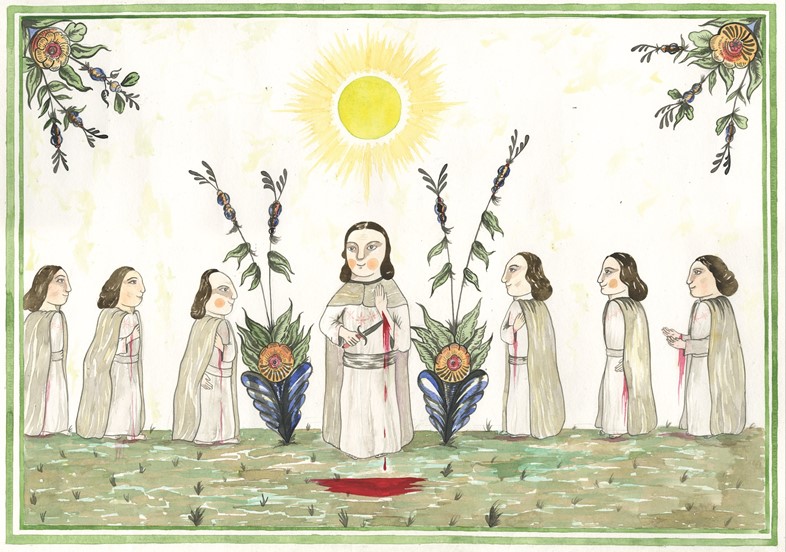
“It’s like the script for the movie in image form,” says Ragnar Persson, the Swedish artist who produced illustrations to fit the film’s rich mythology. When researching the artwork, Persson took inspiration from Hälsinge murals – named after a region of Sweden – which were traditionally used as a means of passing information through generations about the festival, and to celebrate regeneration and fertility.
But while the historic artworks reflect the bucolic existence of 1800s Swedish farming villages, as well as the dominant faith in Christianity, Persson’s drawings – as per Aster – are tweaked to include scenes of human offerings, ritualistic sex, and bloody sacrifices – all of which are, of course, key to Midsommar. “Ari said there was meant to be a lot of blood and sex,” Persson tells me over the phone.
To coincide with the release of the collector’s edition of Midsommar, which comes with a 62-page book illustrated by Persson, we’ve spoken to the Stockholm-based artist about working with Aster, the process behind drawing the murals, and what they mean.
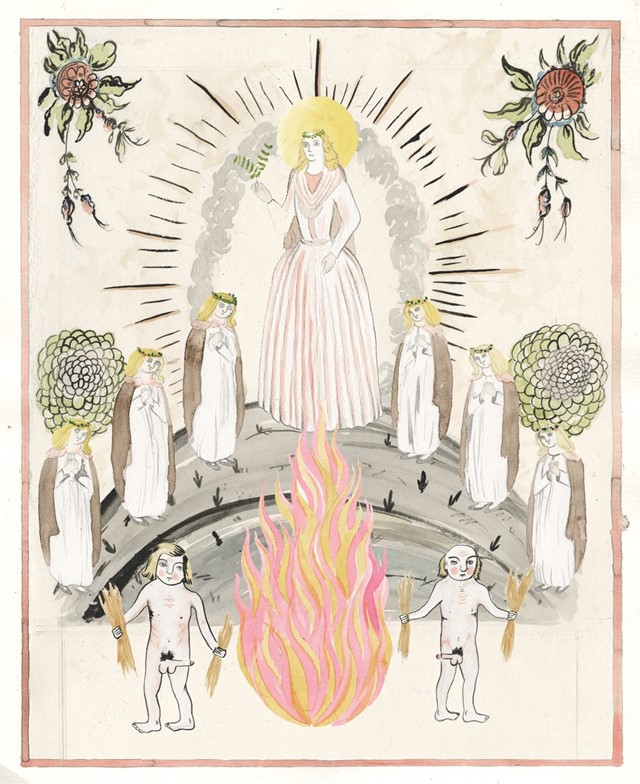
How did you get involved with the project?
Ragnar Persson: It was kind of an accident. I slid in on a banana peel, you could say. Henrik Svensson (the production designer) and I have a mutual friend who recommended me. He contacted me about the project really early on and showed me a dummy script. We did some test drawings and had a brief meeting with Ari, and then everything went really, really fast from then on. The film was meant to be made one year later than it actually was, so it went from nothing to “we need to start working, now”.
How was it working with Ari Aster?
Ragnar Persson: I only met him once actually but he was really nice. We only met for two-three hours when he was in Sweden working on the script. He told me what sort of movie he wanted to make, that he wanted some Bergman references and stuff like that, but mostly all the drawings were made in real time.
Once a drawing was finished, it was put up in the house. There wasn’t that much time for reflection, but Ari was really good with saying, ‘no, I don’t like this’. From my point of view, it was really easy to work with him.
Had you worked on any films prior to Midsommar?
Ragnar Persson: This is only the second film I’ve worked on! I mainly do art exhibitions. I hardly ever do illustration work because I’m really bad at it (laughs), so I stopped that almost ten years ago. I mostly do record covers, which is more my background: punk and heavy metal music – it’s not that commercial.
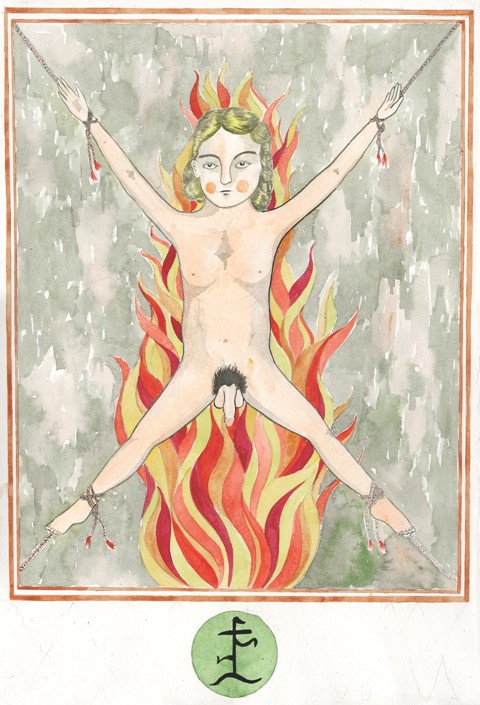
Your art is pretty dark, am I okay to say that (laughs)?
Ragnar Persson: Maybe it’s the Swedish in me (laughs). I mean, we only have three months of sunlight and then it’s dark again.
How would you say your personal work varies from the Midsommar illustrations?
Ragnar Persson: They’re very different. With Midsommar, I was trying to mimic the old Swedish style from Hälsinge where the movie takes place. I was looking at illustrations from the 1800s and early 1900s drawings in the area, and drawing in that style. It was really common that people came and painted not only churches but also houses. I think Sweden has a rich tradition of painting walls, usually they’ll reference everyday life – people harvesting the ground, and there’s a lot of Christianity as well.
How are the illustrations in the film different to the traditional Hälsingland drawings?
Ari said there was meant to be a lot of blood and sex. Similar to how wallpapers in Sweden would depict the harvest, the events that take place in the movie are pictured on the walls, it’s like the script for the movie in image form. Like when Christian sees Josh’s leg sticking out of the mud, or when they crucify Christian, there’s drawings of that. There’s lots of secret messages but maybe it’s better for people to find them by themselves.
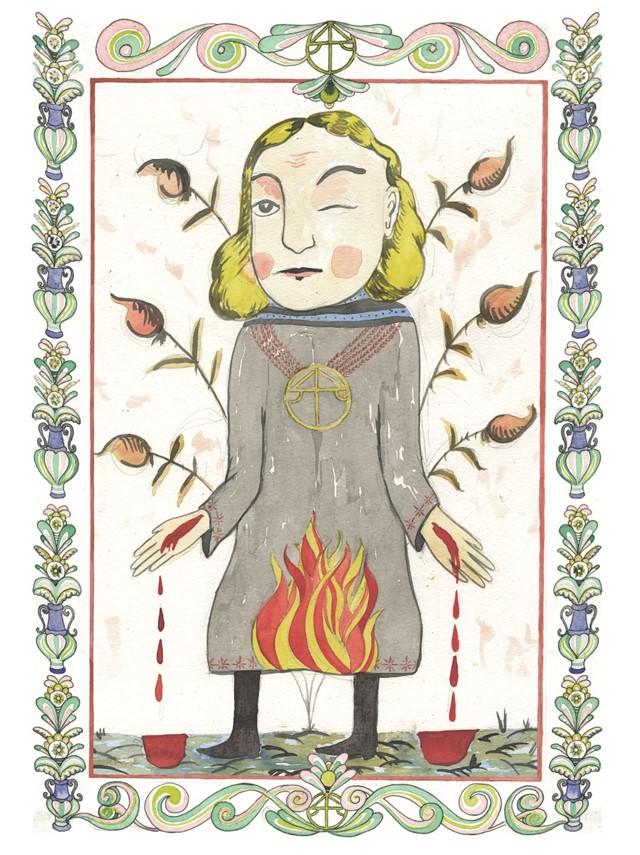
The research process must’ve been pretty thorough. What was your process?
Ragnar Persson: There’s a theme park in Stockholm (Skansen Open-Air Museum) where they have animals and old buildings from all over Sweden. There they have a house that’s completely decorated as if it were in Hälsinge. We had a whole day there with the team, and the guide told us about all the different papers, the symbolism of everything. Then, I bought loads of books – it was all reference-based!
Colour plays a huge role in the film and you can see this in the Youth House, which is filled with your colourful drawings, but the house of Siv is all black and white. Why is that?
Ragnar Persson: Every house was supposed to have different feelings. I think Nille Svensson, who was the graphic designer for everything, came up with the idea to have Siv’s house as black and white. We built the entire wall around the bear (drawing) because there’s the scene where Christian is asked if he wanted to have sex with Maja, and the camera zooms into the bear at that point. A lot of small drawings were made on the day to fill up the walls of the house.
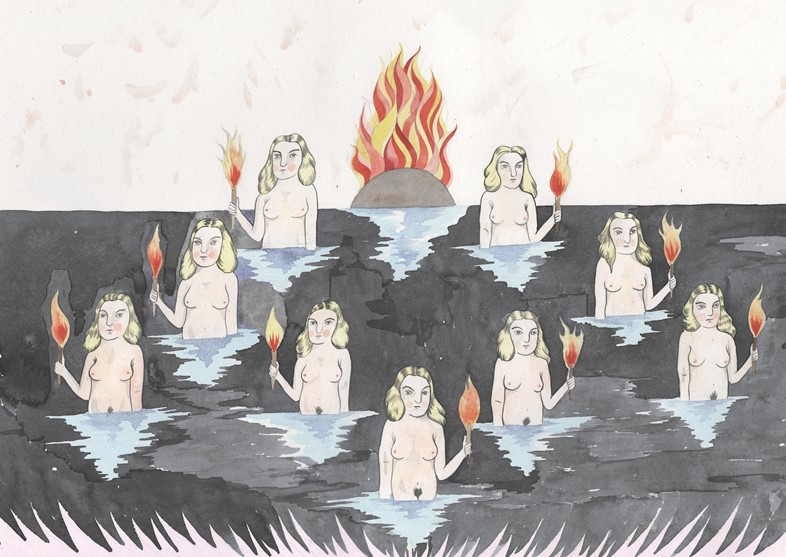
There’s some images, like the woman hanging upside down with the blood pouring into a bowl and the figure blindfolded with a torch, that don’t appear in the film. Where did you get the idea for these?
Ragnar Persson: Because I was working on everything real time, I did a lot of drawings from the script that were later cut from the movie. I guess (the woman hanging upside down) is more symbolic with the human sacrifice and the use of blood as a symbol of connecting with nature. It’s like when the elders cut their hands to leave a bloody mark on the stone before throwing themselves out.
There was another scene where they have a ritual to see how far the harvest is going to go, so they blindfold two people who are walking backwards along the barn, and if the fire’s lit, it’s going to be a good year for the harvest. But if it’s out, it’s going to be a bad year. That whole scene was cut from the movie though, so it doesn’t make sense, but I think it’s nice that not everything is explained.
Yeah, the fire motif crops up a lot in the drawings. What does it represent?
Ragnar Persson: The fire’s really central to the story but I’m not sure if it’s pointed out in the film. Basically, the fire is sacred so it can never go out, it’s always burning. Maybe it’s society as a whole, like if they don’t take care of it, it’ll go out. It’s a community and you have to keep feeding it so that it carries on burning.
The new collector’s edition of Midsommar is available to order via A24’s website, and is set to ship by July 20
